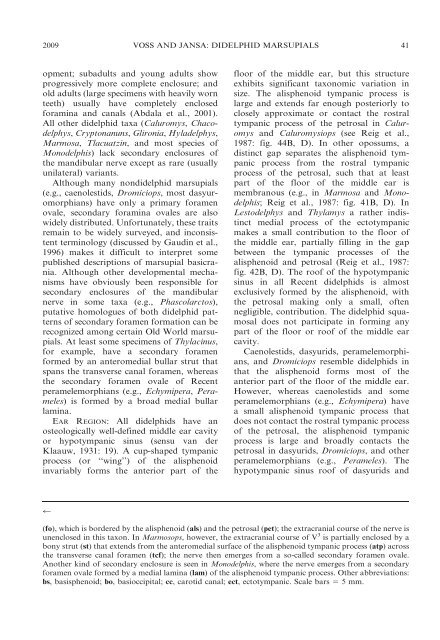phylogenetic relationships and classification of didelphid marsupials ...
phylogenetic relationships and classification of didelphid marsupials ...
phylogenetic relationships and classification of didelphid marsupials ...
Create successful ePaper yourself
Turn your PDF publications into a flip-book with our unique Google optimized e-Paper software.
2009 VOSS AND JANSA: DIDELPHID MARSUPIALS 41<br />
opment; subadults <strong>and</strong> young adults show<br />
progressively more complete enclosure; <strong>and</strong><br />
old adults (large specimens with heavily worn<br />
teeth) usually have completely enclosed<br />
foramina <strong>and</strong> canals (Abdala et al., 2001).<br />
All other <strong>didelphid</strong> taxa (Caluromys, Chacodelphys,<br />
Cryptonanuns, Glironia, Hyladelphys,<br />
Marmosa, Tlacuatzin, <strong>and</strong> most species <strong>of</strong><br />
Monodelphis) lack secondary enclosures <strong>of</strong><br />
the m<strong>and</strong>ibular nerve except as rare (usually<br />
unilateral) variants.<br />
Although many non<strong>didelphid</strong> <strong>marsupials</strong><br />
(e.g., caenolestids, Dromiciops, most dasyuromorphians)<br />
have only a primary foramen<br />
ovale, secondary foramina ovales are also<br />
widely distributed. Unfortunately, these traits<br />
remain to be widely surveyed, <strong>and</strong> inconsistent<br />
terminology (discussed by Gaudin et al.,<br />
1996) makes it difficult to interpret some<br />
published descriptions <strong>of</strong> marsupial basicrania.<br />
Although other developmental mechanisms<br />
have obviously been responsible for<br />
secondary enclosures <strong>of</strong> the m<strong>and</strong>ibular<br />
nerve in some taxa (e.g., Phascolarctos),<br />
putative homologues <strong>of</strong> both <strong>didelphid</strong> patterns<br />
<strong>of</strong> secondary foramen formation can be<br />
recognized among certain Old World <strong>marsupials</strong>.<br />
At least some specimens <strong>of</strong> Thylacinus,<br />
for example, have a secondary foramen<br />
formed by an anteromedial bullar strut that<br />
spans the transverse canal foramen, whereas<br />
the secondary foramen ovale <strong>of</strong> Recent<br />
peramelemorphians (e.g., Echymipera, Perameles)<br />
is formed by a broad medial bullar<br />
lamina.<br />
EAR REGION: All <strong>didelphid</strong>s have an<br />
osteologically well-defined middle ear cavity<br />
or hypotympanic sinus (sensu van der<br />
Klaauw, 1931: 19). A cup-shaped tympanic<br />
process (or ‘‘wing’’) <strong>of</strong> the alisphenoid<br />
invariably forms the anterior part <strong>of</strong> the<br />
r<br />
floor <strong>of</strong> the middle ear, but this structure<br />
exhibits significant taxonomic variation in<br />
size. The alisphenoid tympanic process is<br />
large <strong>and</strong> extends far enough posteriorly to<br />
closely approximate or contact the rostral<br />
tympanic process <strong>of</strong> the petrosal in Caluromys<br />
<strong>and</strong> Caluromysiops (see Reig et al.,<br />
1987: fig. 44B, D). In other opossums, a<br />
distinct gap separates the alisphenoid tympanic<br />
process from the rostral tympanic<br />
process <strong>of</strong> the petrosal, such that at least<br />
part <strong>of</strong> the floor <strong>of</strong> the middle ear is<br />
membranous (e.g., in Marmosa <strong>and</strong> Monodelphis;<br />
Reig et al., 1987: fig. 41B, D). In<br />
Lestodelphys <strong>and</strong> Thylamys a rather indistinct<br />
medial process <strong>of</strong> the ectotympanic<br />
makes a small contribution to the floor <strong>of</strong><br />
the middle ear, partially filling in the gap<br />
between the tympanic processes <strong>of</strong> the<br />
alisphenoid <strong>and</strong> petrosal (Reig et al., 1987:<br />
fig. 42B, D). The ro<strong>of</strong> <strong>of</strong> the hypotympanic<br />
sinus in all Recent <strong>didelphid</strong>s is almost<br />
exclusively formed by the alisphenoid, with<br />
the petrosal making only a small, <strong>of</strong>ten<br />
negligible, contribution. The <strong>didelphid</strong> squamosal<br />
does not participate in forming any<br />
part <strong>of</strong> the floor or ro<strong>of</strong> <strong>of</strong> the middle ear<br />
cavity.<br />
Caenolestids, dasyurids, peramelemorphians,<br />
<strong>and</strong> Dromiciops resemble <strong>didelphid</strong>s in<br />
that the alisphenoid forms most <strong>of</strong> the<br />
anterior part <strong>of</strong> the floor <strong>of</strong> the middle ear.<br />
However, whereas caenolestids <strong>and</strong> some<br />
peramelemorphians (e.g., Echymipera) have<br />
a small alisphenoid tympanic process that<br />
does not contact the rostral tympanic process<br />
<strong>of</strong> the petrosal, the alisphenoid tympanic<br />
process is large <strong>and</strong> broadly contacts the<br />
petrosal in dasyurids, Dromiciops, <strong>and</strong> other<br />
peramelemorphians (e.g., Perameles). The<br />
hypotympanic sinus ro<strong>of</strong> <strong>of</strong> dasyurids <strong>and</strong><br />
(fo), which is bordered by the alisphenoid (als) <strong>and</strong> the petrosal (pet); the extracranial course <strong>of</strong> the nerve is<br />
unenclosed in this taxon. In Marmosops, however, the extracranial course <strong>of</strong> V 3 is partially enclosed by a<br />
bony strut (st) that extends from the anteromedial surface <strong>of</strong> the alisphenoid tympanic process (atp) across<br />
the transverse canal foramen (tcf); the nerve then emerges from a so-called secondary foramen ovale.<br />
Another kind <strong>of</strong> secondary enclosure is seen in Monodelphis, where the nerve emerges from a secondary<br />
foramen ovale formed by a medial lamina (lam) <strong>of</strong> the alisphenoid tympanic process. Other abbreviations:<br />
bs, basisphenoid; bo, basioccipital; cc, carotid canal; ect, ectotympanic. Scale bars 5 5 mm.

















